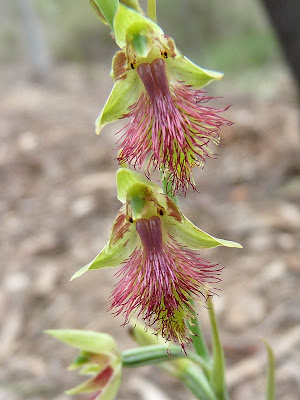I very recently spent a day in one of my favourite parks (though admittedly there are quite a few of those!). One of the reasons I'm so fond of Monga though, is that for a while there it looked as though we might lose it to logging. Thanks to the unflagging efforts of a very passionate and determined group of people in the 1980s and 90s, researching, lobbying, even taking direct action in the forest when dialogue and science seemed to be failing, the park was declared, comprising 26,000 hectares of state forest, in 2001. By then the sawmill had already closed, after decades of over-cutting.
It sits on top of the coastal escarpment; immediately inland lie the frosty grasslands of the Monaro Plains, but as the moist coastal air climbs the scarp and meets the lower temperatures higher up, rain results, enabling wet eucalypt forests and even rainforest to thrive. Ferns are a feature.
 |
| Wet eucalypt forest over Soft Tree Ferns (Dicksonia antarctica) |
One of the highlights of the Monga year is the flowering of the Monga Waratah (Telopea mongaensis), which occurs in early November. There are five species of Telopea, in the old Gondwanan family Proteaceae, closely related to the Notros of Patagonia. This one is not limited to the Monga, despite the name, but its small distribution is centred on here.
 |
Waratah flower heads comprise a cluster of individual bright red flowers sitting on a disc,
clumped for greater visibility to the birds which pollinate them.
There will be more on waratahs in a future posting! |
Perhaps the most important aspect of the Monga however is the unusual and ancient cool temperate rainforest, a direct legacy of Gondwana, dominated by Pinkwood (Eucryphia moorei); other Eucryphias are found in Tasmania (where they produce the famous Leatherwood honey) and in Chile.
 |
| Pinkwood, Monga National Park, above and below. |
Another thing that gives me a particular affinity to the Monga relates to a rather shocking coincidence. When I first visited in 1986, we stumbled on the aftermath of what felt at the time like a massacre. Illegal tree fern cutters had been in the previous night, taking scores of old tree ferns out to sell probably at markets in Sydney; the fresh leaves littered the ground among the cut-off stumps. Tree ferns grow only from the tip, so while the plundered logs would have regrown, the remaining stumps were dead. This killing ground forms the focus of a beautiful board walk installed and interpreted by the New South Wales National Parks Service; poignantly, they have called it Penance Grove. The dead stumps are a constant reminder of that dark day.
 |
| Penance Grove, Monga National Park. |
There are however still many living ferns to celebrate.
 |
| Rough Tree Fern, Cyathea sp. |
 |
| Soft Tree Fern fronds unfurling. |
The Mongarlowe River runs through the centre of the Park.
 |
| Spent Waratah flowers floating in the Mongarlowe River. |
The Monga is also a wonderful place for bird-watching; wherever you are, there's a yellow robin.
 |
| Eastern Yellow Robin. |
Why not go and visit her? Not to mention all the other delights of this very special place.
(The turnoff to the park is clearly marked, just over 20km south-east of Braidwood along the Kings Highway to Batemans Bay. The edge of the park is just 2km in, along a good all-weather gravel road.)




















































